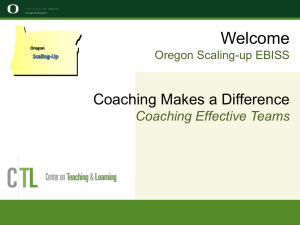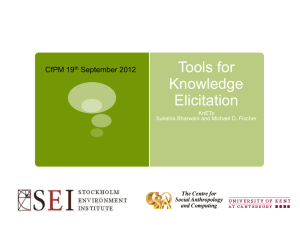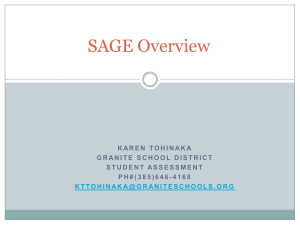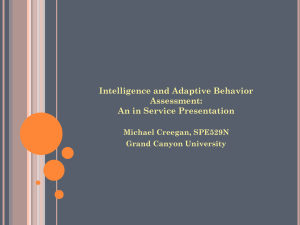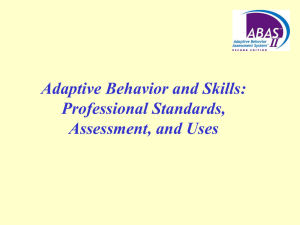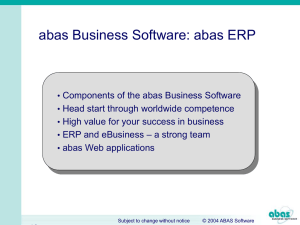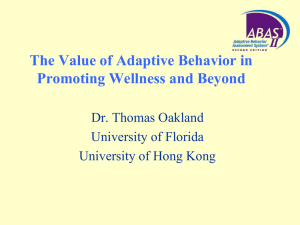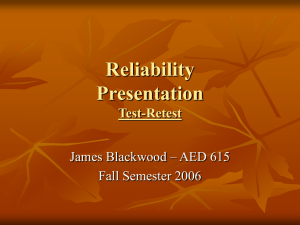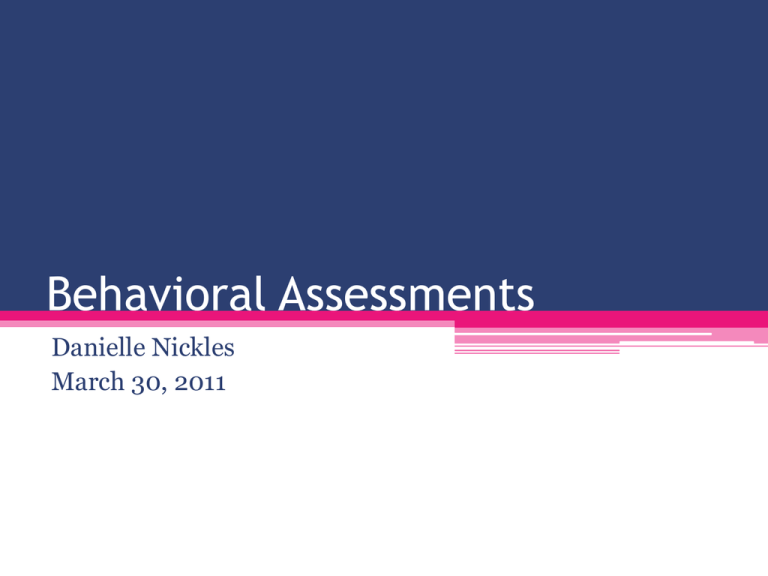
Behavioral Assessments
Danielle Nickles
March 30, 2011
Behavioral Assessment for Children, Second Edition
BASC-2
• Behavioral Assessment for Children, Second
Edition
▫ Multimethod
▫ Multidimensional
▫ Used to evaluate self-perceptions and behaviors of
people ages 2-25
For ages 18-25, there is a modified Self Report
version for use
Multimethod
•
•
•
•
•
Parent Rating Scale
Teacher Rating Scale
Self Report Scale
Structured Developmental History Form
Student Observation System
▫ A form for organizing behaviors observed in the
classroom
Multidimensional
• Measures numerous types of behaviors
▫ Positive/adaptive
▫ Negative/clinical
Parent/Teacher/Self
• Each form is answered on a 4-point Likert Scale
▫
▫
▫
▫
Never
Sometimes
Often
Almost Always
• Each form takes between 10-30 minutes
▫ The teacher form is the shortest
Strengths of the BASC-2 (to name a
few)
• Not only does the BASC-2 assess for
personality/behavioral problems, the test will
provide you with some of the clients strengths
• Addresses symptoms concurrent with the DSM
and IDEA
• High internal consistency and test-retest
reliability
• Available in Spanish
Research behind the BASC-2
• Normative Samples
▫ General Norms: based on a representative sample
of population
Sex, race/ethnicity, parent education, geographic
region, clinical/special education classification
▫ Clinical Norms
ADHD norms and LD norms
Research behind the BASC-2
• Validity Indexes
▫ F Index: respondent is excessively negative
▫ L-Index: child’s tendency to paint an extremely
pretty portrait of themselves
▫ V- Index: Highly implausible statement
▫ Consistency Index: respondent answers differently
to questions that should be answered the same*
▫ Response Pattern Index: detects patterns in
responses*
*software scoring only
Research behind the BASC-2
• Teacher Rating Scale
▫ Internal Consistency: high .80’s to high .90’s
▫ Test-Retest: mid .80’s to low .90’s
▫ Inter-rater Reliability: .53-.65 dependent on age
Research behind the BASC-2
• Parent Rating Scale:
▫ Internal Consistency: mid .80’s to high .90’s
▫ Test-Retest: low .80’s to low .90’s
▫ Inter-rater Reliability: .69-.77 dependent on age
Research behind the BASC-2
• Self Report of Personality
▫ Internal Consistency: mid .80’s to mid .90’s
▫ Test-Retest: high .70’s to low 80’s
This becomes better at the college level
Adaptive Behavior Assessment System, Second Edition
ABAS II
• Adaptive Behavior Assessment System, Second
Edition
▫ Provides assessment of adaptive skills, identifies
strengths and limitations, and monitor’s progress
over time
▫ Produces scores for a General Adaptive
Composite, specific Skills Areas, and Adaptive
Domains
▫ Normed for ages 0-89 years
10 Skill
Areas
3 Adaptive
Domains
• Skill Areas
▫
▫
▫
▫
▫
▫
▫
▫
▫
▫
Communication
Community Use
Functional (Pre)Academics
School/Home Living
Health and Safety
Leisure
Self-Care
Self-Direction
Social
Motor/Work
General
Adaptive
Composite
• Adaptive Domains
▫ Conceptual
▫ Social
▫ Practical
ABAS II: Adaptive?
• What does adaptive mean?
▫ When measuring adaptive behaviors on the ABAS
II, you are measuring the amount of difficulty with
daily skills necessary for functioning
ABAS II
• Results can be used to make diagnostic decisions
and to plan interventions/services
• Special Education and Disability services usually
require an evaluation of adaptive skills
Forms included in the ABAS II
• Parent/Primary Caregiver
▫ 0-5 years
▫ 241 items
• Parent
▫ 5-21 years (K-12)
▫ 232 items
• Teacher/Daycare Provider
▫ 2-5 years
▫ 216 items
• Teacher
▫ 5-21 years (K-12)
▫ 193 items
• Adult
▫ 16-89 years
▫ Self-report and Reported by others
▫ 239 items
Psychometric Properties: ABAS II
• Norms
▫ Are representative of the US population based on
gender, race/ethnicity, and parent-education level
• Validity
▫ Not reported in the manual
Psychometric Properties: ABAS II
Reliability
• Internal Consistency:
▫ GAC: .97-.99
▫ Adaptive Domains: .91-.98
▫ Skill Areas: .80-.97
• Test-Retest:
▫ GAC: .9o’s
▫ Adaptive Domains: high .80’s – 90’s
▫ Skill Areas:
Infant/preschool: .70’s, .80’s, and .90’s
School age/adults: .80’s-.90’s
Psychometric Properties: ABAS II
Reliability
• Cross Form Consistency
▫ Teacher/Daycare and Parent/Primary Caregiver: .68
▫ School age Teacher and Parent: .70
▫ Adult Self and Other: .94
• Inter-Rater:
▫
▫
▫
▫
▫
Teacher/Daycare: .81
Teacher: .90
Parent/Primary Caregiver: .82
Parent: .91
Adult: (when individual was rated by 2 respondents)
.89-.93

